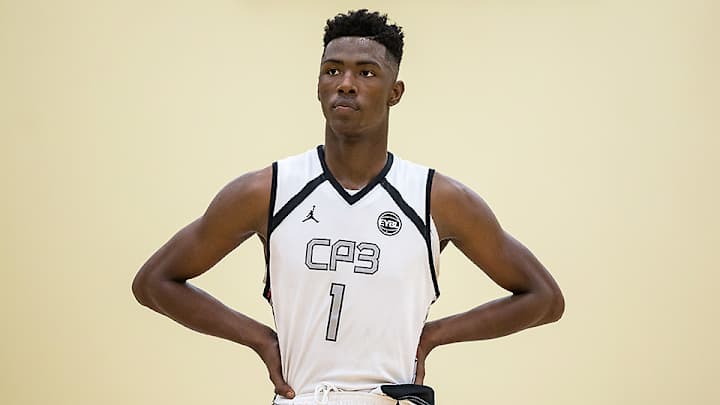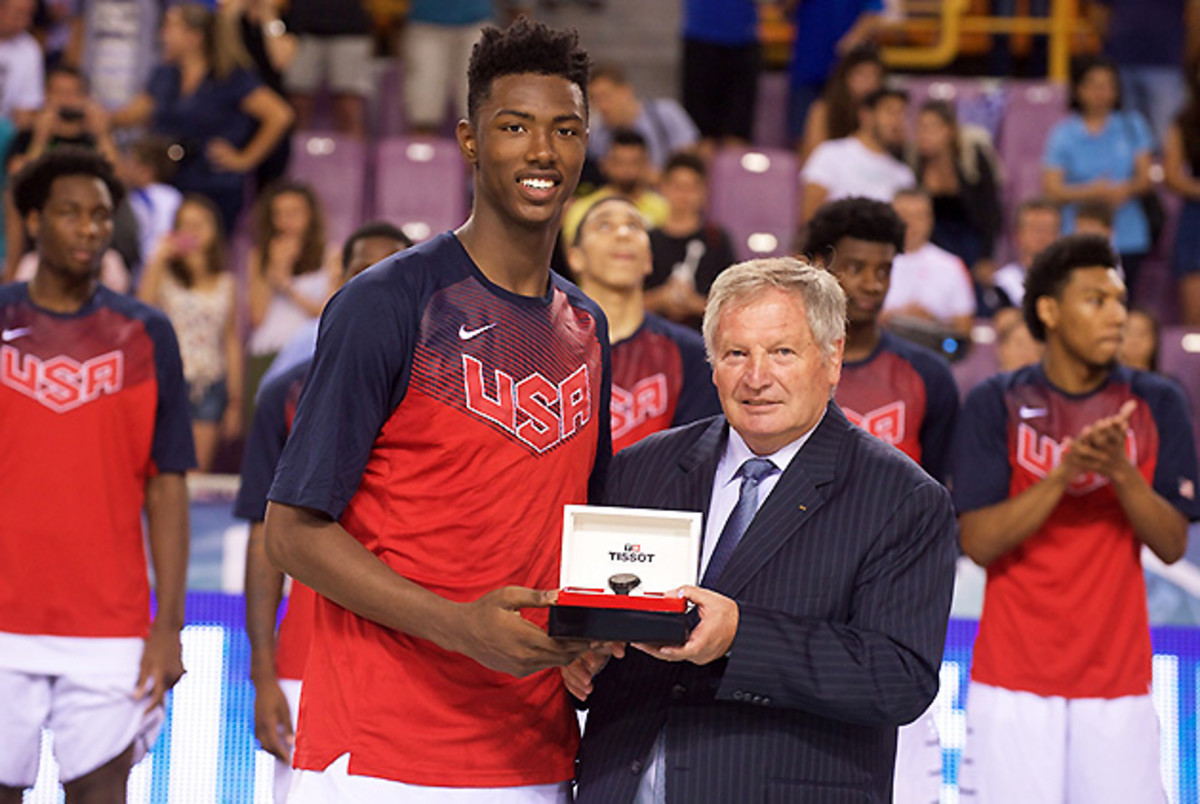Ahead of anticipated college choice, Harry Giles continues to grow game

HERAKLION, Crete, Greece — Two days before USA Basketball closed its Under-19 minicamp in Colorado Springs and left for the world championships in Greece, the team's coaching staff called Harry Giles in for a private film session. Giles, if you're not acquainted with him yet, is a 6'10" forward who's the No. 1 or 2 player in the high school class of 2016, depending on which recruiting service you prefer; the YouTube highlight reels he stars in have descriptors such as "Best NBA Prospect In High School Basketball," "Man Child," "Monster," and "Harry Giles Can't be Stopped." But what Team USA's coaches—Arizona's Sean Miller; his brother, Dayton's Archie Miller; and Providence's Ed Cooley—showed Giles was different genre of mixtape: the reality check.
They watched clips from the 2013 U19 team's gold-medal run, specifically of Aaron Gordon, now of the Orlando Magic, and Montrezl Harrell, recently drafted by the Houston Rockets, defending like madmen in a fullcourt press. Then they watched clips of Giles defending on the same press in practice, letting him observe the contrast. Things had always come easy for the 17-year-old—it's no stretch to call him the world's most physically gifted, young frontcourt prospect—but if Gordon and Harrell's effort level on the tape was a 9 or 10 (out of 10), Giles's was only a 3 or 4.
Jalen Brunson, Harry Giles star as USA wins FIBA U19 World Championship
"I was sitting there and realizing I wasn’t playing as hard as I could," Giles recalled. "And they basically asked me, 'What do you want to be in two years? These guys were in your exact spot, and look at where they are now.' Coach Archie [Miller] was like, 'This tournament can make you. You dominate this tournament, win this gold medal against 19-year-olds, you might not have to do anything else. But you're approaching it like you're not taking advantage of it.'
"From then on, every day, I tried to bring it."
When the U.S. went on its 7-0, gold-medal run in Crete, Giles was one of its primary sources of energy. Despite being a full two years younger than many players in the U19s, Giles was arguably the tournament's most impactful defender, finishing first in defensive win shares per 40 minutes (0.21) and defensive rebound percentage (28.7). He protected the rim, held his own on ball-screen switches—and he also scored enough to close the U19s with five straight double-doubles and make its all-tournament team. Sean Miller called Giles's productivity "astonishing" for his age, and said his change in energy level made him Team USA's most-improved player during its time together.
"If Harry could make that kind of turnaround in a couple-week period," Miller said, "I think you know what the next decade will represent for him."
There were NBA scouts in Crete who called Giles the early frontrunner for the No. 1 pick in 2017, and said his face-up versatility could make him a future All-Star. But the biggest question facing Giles, at the moment, is over something he'll do in the next 10 months: pick a college for 2016-17.
Now that St. Louis product Jayson Tatum, a silky, 6'8" small forward and Giles's prime competition for title of the nation's No. 1 recruit, has chosen Duke—making the announcement at the Nike Peach Jam on Sunday, with Coach K in attendance—scrutiny on Giles's decision has intensified. He and Tatum were roommates in Greece and, despite attending high school 700 miles apart, are best friends. Their connection, Giles said, is that "we have the same lifestyle, just in a different city, different state. We have the same dreams, so when you've got somebody like that, who has just as much to lose as you do, you keep each other motivated and doing the right thing at all times."
When I asked Giles, in Crete, whether he wanted to team up with Tatum in college, he paused for a second, and then said, "Honestly, yes. It's most definitely what we talk about. We've gotta make the best decisions for both of us, though. We're still going to be boys regardless of if we go to the same school."
Giles still has eight schools on his list (Duke, Kansas, Kentucky, North Carolina, Ohio State, Syracuse, UNLV and Wake Forest) and has yet to schedule official visits. But both he and his father, Harry Giles Jr., said their top two priorities for picking a college were player development and the chance to win a national championship in Year 1, so the surrounding cast will be a major factor. "When we evaluate programs," Giles Jr. said, "we're going to be asking, who will give [Harry] the best opportunity to win it all?"
• MORE: Michael Porter Jr. & Trae Young also mulling package deal
And yet, the lone school on that list with a losing record last season—Wake Forest, which went 13-19—still believes it has a fighting chance. The elementary school Giles attended, First Assembly Christian, is literally across the street from Wake's campus, and he's remained in Winston-Salem rather than bolting for major prep schools. In the spring and summer, he plays for the AAU program of former Wake Forest star Chris Paul, the CP3 All-Stars.
Giles's parents have deep roots in the community, too. Giles Jr. played football and basketball at Winston-Salem State from 1984-88 and now teaches physical education and health at the city's Abraham Elementary School. Giles's parents are divorced, and his mother, Melissa Addison-Giles, with whom he lives, has owned and operated Salon Salon, a hair salon in Winston-Salem, for 23 years. Addison-Giles isn’t too concerned with proximity; when I asked her how much that factored into the college choice, she said, from her front-row seat at the games in Crete, "You do see where I'm at, right? The mom travels." But she, Giles Jr. and their son are all intrigued by Wake Forest's coach, Danny Manning, who's working an angle that none of his recruiting competition can match.

Last season, during a visit to Giles's high school, Wesleyan Christian Academy, Manning gave a custom video presentation on an iPad. "I had to watch it twice," Addison-Giles said, "because it was amazing."
It started with a head-to-head comparison of the bio of Harry Giles III vs. Danny Manning—as a player. Both 6'10" power forwards with versatile skill sets. Both sons of undersized power forwards who were elite athletes. Both high-school stars in the Piedmont Triad (Manning starred in Greensboro before moving to Lawrence, Kan.). Both No. 1 recruits in the nation. Both members of medal-winning USA Basketball teams.
Going Greek: Tyler Dorsey's journey from California to Greece's U19 team
Next came the game footage. There was a clip of Giles scoring on an off-the-bounce basket-attack, followed by a vintage clip of Manning doing it the same way. Then a clip of Manning executing a spin move in the post to set up a dunk, then one of Giles doing the same thing. Then an athletic Giles block, followed by a young Manning making an identical play. The message was clear: No one understands how to showcase and develop Giles more than Manning, who's been in all the same positions.
"It was cool, and it was weird," Giles said. "It was like he was my twin, or like I'm him, 30 years [actually 32] later."
Manning and Giles are so similar that they even share the experience of having suffered major knee injuries. The difference is that Manning's injuries occurred while in the NBA, first as a rookie in 1989 (a right ACL tear) and then 1995 (left ACL), and they altered the course of what might have been a Hall of Fame career. Giles's occurred while he was a 15-year-old playing for USA Basketball in Uruguay in 2013, and it was so significant that, he said, "I thought I was done as a basketball player."
The diagnosis was a torn left ACL, MCL and meniscus, but due to advances in medicine and his aggressive rehab, he was playing without a knee brace in Greece, two summers later, and looking like one of the best young athletes in the world. Aside from the pen-length scar just below Giles's left kneecap, there was little sign that the injury even happened.
• MORE: Breaking down college basketball's top 25 recruits in 2015
As the recruiting world waits on Giles to pick a college, speculating on whether he'll further enrich Duke, or revitalize Wake Forest or some other program, what should be appreciated in the meantime is Giles's ability to keep transforming while he's at the top. He's gone from promising, to hobbled, to dominant, all before his senior year of high school. As a 17-year-old on Team USA, when coaches confronted him about his sluggishness, he found a new, gold-worthy energy level. Addison-Giles says her son simply does not like to stagnate, even when it comes to his hair, which she washes at her salon. While Addison-Giles was watching him in Crete, en route to one of his U19 double-doubles, she told me to Google photos of her son and try to track his changing hairstyles.
"You'll think years are passing, but really, it's months," she said. "The differences are just that dramatic."
